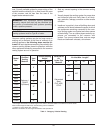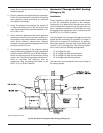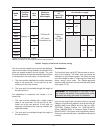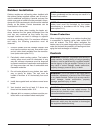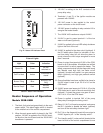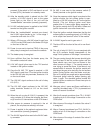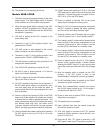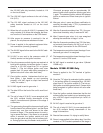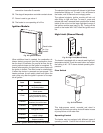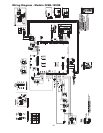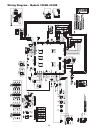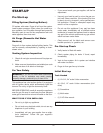
35
45. The Heater is now operating at full fire.
Models 989B–2339B
1. The black (hot) wire lead goes directly to the main
power switch. This black toggle switch is located
at the middle front of the control compartment.
2. When the main power switch is placed in the “ON”
position, 120 VAC is applied to the 120 VAC termi-
nal block on the circuit board and the 120/24 VAC
transformer is powered.
3. 120 VAC is waiting at the N.O. contacts of the
pump delay relay.
4. Terminals L1 and F1 of the ignition module 1 are
powered with 120VAC.
5. 120 VAC power is also applied to the control
power connector on the circuit board.
6. Terminals L1 and F1 of the ignition module 2 are
powered with 120VAC (1529B-2349B only).
7. 120 VAC power is waiting at relay contacts K-4 to
energize the heater blowers.
8. The 120/24 VAC transformer outputs 24 VAC.
9. 24 VAC is sent to power terminal L1 of the low
water cut-off board (optional).
10. 24 VAC is applied to the red LED safety shutdown
light on the front of the unit.
11. 24 VAC is applied to the alarm circuit (optional). If
the E-5 sales option (Alarm) is included a 5 sec-
ond time delay relay will not allow the alarm to
sound unless the circuit stays energized for more
than 5 seconds.
12. Power is output from terminal J5-24V of the CPW
board to all of the safeties. All safeties are verified
to ensure that it is safe to operate the heater. The
safety components wired into the diagnostic board
are: Manual reset high limit, low water cut-off
(optional), blocked vent switch, low gas pressure
switch, and high gas pressure switch(s) (optional).
13. Once all safeties have been verified to be closed a
24 VAC signal is sent to pin P3-16 of J-5 on the
CPW board.
14. 24 VAC power now leaves pin P3-16 of J-5 on the
CPW board and is sent to the auto-reset high limit
(optional). If closed the power now goes to termi-
nal P1-4 of J-5 on the CPW board.
15. Power is applied to terminal 24V of the pump
delay relay to energize the timing circuit.
16. Relay K-1 (N.C.) will now be energized, and opens
the N.C. contacts to disable the alarm (optional)
and turn off the red safety shutdown light.
17. Terminal J4-24 on the CPW board will now output
a 24 VAC signal to pin 1 of the “standby switch”.
18. The “standby switch” (rocker switch) located at the
lower left front of the control compartment is now
powered. If the switch is “ON” and there is no call
for heat (CFH), the heater is in standby mode.
19. The “standby switch” (rocker switch) located at the
lower left front of the control compartment is now
powered. If the switch is “ON” and there is no call
for heat (CFH), the heater is in standby mode.
20. Power is applied to the coil of K-3. (If an ignition
lockout occurs, ignition module 1 closes contacts
allowing the 24VAC from K-3 to go to ground and
closes the contacts to allow the unit to fire at stage
3.)
21. After the standby switch is placed into the “ON”
position, a 24 VAC signal is sent to the
“enable/disable” connection (normally jumpered).
22. 24 VAC switched power is applied to the 24VAC
terminals on ignition modules 1 and 2.
23. When the “enable/disable” contacts are closed,
the 24 VAC signal travels to pin 1 of the stage 1
connection and waits for a CFH.
24. Power is now sent to terminal TRIG of the pump
delay relay to energize it.
25. The heater pump is energized.
26. Upon sufficient flow from the heater pump, the
flow switch contact will close.
27. A 24 VAC signal is now sent to the “TH” terminal
located on ignition module 1 and to the N.O. con-
tacts of K-2 and K-3.
28. Once the 24 VAC “TH” signal is received, a 120
VAC signal is sent from F2 on ignition module 1 to





